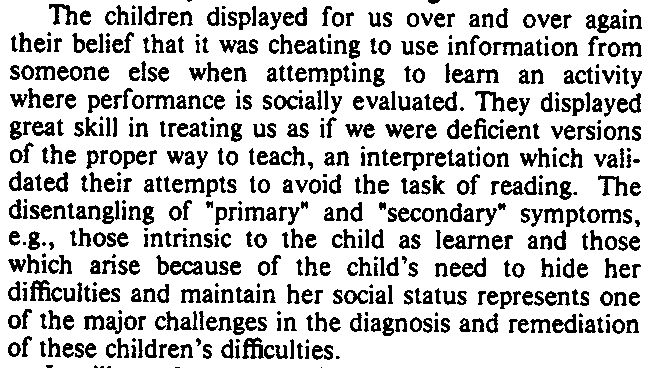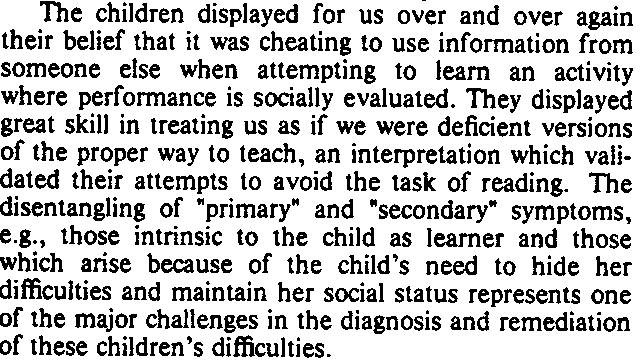[Date Prev][Date Next][Thread Prev][Thread Next][Date Index][Thread Index]
RE: RE: [xmca] Fleer/Hedegaard for discussion
Well. . . i was wondering if that image would transfer but it did not.
Here is what it said: "The children displayed for us over and over again
their belief that it was cheating to use information from someone else
when attempting to learn an activity where performance is socially
evaluated. They displayed great skill in treating us as if we were
deficient versions of the proper way to teach, an interpretation which
validated their attempts to avoid the task of readin. The disentangling
of "primary" and "secondary" symptoms, e.g., those intrinsic to the child
as learner and those which arise because of the child's need to hide her
difficulties and maintain her social status represents one of the major
challenges in the diagnosis and remediation of these children's
difficulties (p 64)."
thanks,
eric
ERIC.RAMBERG@spps.org
Sent by: xmca-bounces@weber.ucsd.edu
05/06/2010 09:59 AM
Please respond to "eXtended Mind, Culture, Activity"
To: "eXtended Mind, Culture, Activity" <xmca@weber.ucsd.edu>
cc:
Subject: RE: RE: [xmca] Fleer/Hedegaard for discussion
Hello all:
The following archived LCHC newsletter written in July of 1982 discusses
much of this "socially situated institutional practices" in the beginning
time of the development of the 5th dimension.
http://lchc.ucsd.edu/Histarch/jl82v4n3.PDF
Here is an excerpt:
I enjoyed the article as well and appreciate any research that provides
insight into how institutional practices can impact the development of a
child. Thank you to the authors for such great work!
eric
"White, Phillip" <Phillip.White@ucdenver.edu>
Sent by: xmca-bounces@weber.ucsd.edu
05/05/2010 01:35 PM
Please respond to "eXtended Mind, Culture, Activity"
To: "eXtended Mind, Culture, Activity" <xmca@weber.ucsd.edu>
cc:
Subject: RE: RE: [xmca] Fleer/Hedegaard for discussion
Larry - your analysis fits with my understanding of agency, engagement and
identity. as Lave points out, these attributes do emerge out of
participation within activities -
also, while i have my own goals for the classroom, these goals are not
necessarily shared by the other participants within the classroom -
one point: you wrote -
"What the Fleer/Hedegaard article points out is how the REGULATORY
FUNCTION of socially situated institutional practices constrains [and
affords] particular developmental pathways. What I want to add is the
construct of ENGAGEMENT [as a movement or tension of RESPONSE and
WITHDRAWAL] and how institutional structures REGULATE this function of
engagement [or disengagement] "
i'm not so sure that Andrew is being confronted by "socially situated
institutional practices" as what i understand to be socially situated
practices operationalized by the classroom teacher(s).
the classroom teacher(s), i would think, had other ways of responding to
Andrew.
phillip
Phillip White, PhD
University of Colorado Denver
School of Education
phillip.white@ucdenver.edu
_______________________________________________
xmca mailing list
xmca@weber.ucsd.edu
http://dss.ucsd.edu/mailman/listinfo/xmca
_______________________________________________
xmca mailing list
xmca@weber.ucsd.edu
http://dss.ucsd.edu/mailman/listinfo/xmca


_______________________________________________
xmca mailing list
xmca@weber.ucsd.edu
http://dss.ucsd.edu/mailman/listinfo/xmca
